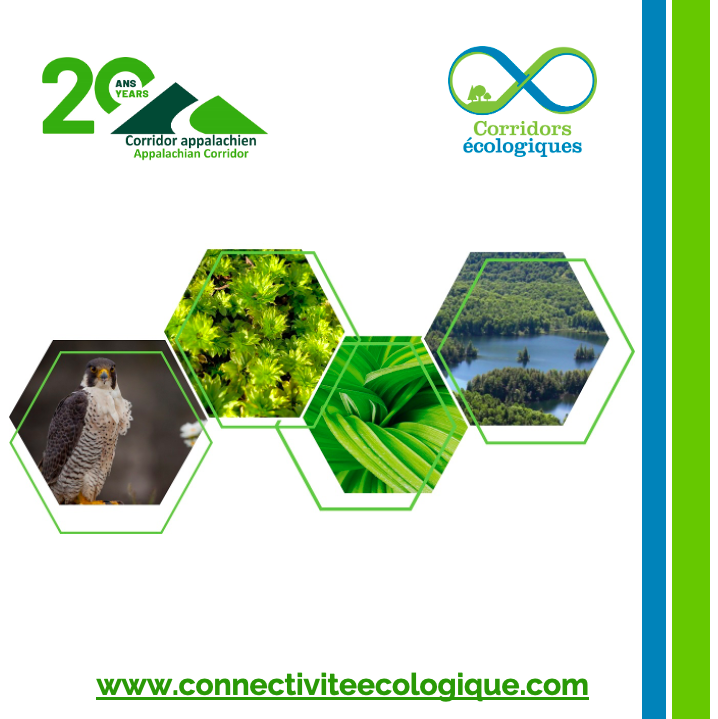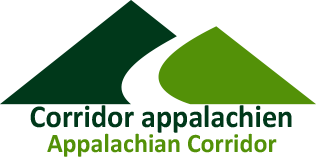
22 Mar EMBRACING ECOLOGICAL CONNECTIVITY IN MUNICIPAL SETTINGS: TWO NEW TOOLBOXES TO INSPIRE ACTION

Eastman, QC (March 22, 2022) – The magnitude of the current climate and ecological crisis calls on all stakeholders to mobilize to mitigate and even reverse the situations facing our society and our planet. It is this context which prompted Appalachian Corridor, a conservation organization working in the Eastern Townships, to orchestrate the development of two new toolboxes (one for municipalities and one for MRCs), that were unveiled today during a virtual conference. These tools aim to inspire and accelerate the consideration for ecological connectivity specifically at the level of municipal authorities and across the province of Quebec.
“Through their own planning and regulatory mechanisms, municipalities and MRCs hold the key to fostering healthy natural environments and thus promoting the implementation of natural solutions to the challenges posed by climate change,” explained Mélanie Lelièvre, Executive Director of Appalachian Corridor, to the three hundred elected officials and members of the conservation ecosystem attending the event.
“In addition to the initiatives led by the federal and provincial governments and conservation organizations, municipalities and MRCs play essential roles in the maintenance and protection of natural environments. We are convinced that by using our toolboxes, these authorities can accelerate their efforts and generate significant gains,” added Ms. Lelièvre.
Developed as part of the Initiative Québécoise Corridors écologiques (IQCE), the toolboxes have been incorporated into the www.connectiviteecologique.com platform and are currently available in French.
By combining theoretical and practical content, the toolboxes aim to accompany elected officials and municipal employees by: demonstrating the importance of ecological connectivity; presenting regulatory tools and other strategies that promote and frame its consideration; and providing concrete examples of municipalities and MRCs that have begun incorporating ecological connectivity into their regulations and decisions.

ECOLOGICAL CONNECTIVITY AND ADAPTATION TO CLIMATE CHANGE
Ecological connectivity is defined as the degree of connection between the various natural environments within a landscape, in terms of their components, spatial distribution and ecological functions. Over the years, the landscape has been modified and fragmented by human activities and development.
“Good ecological connectivity is essential to the health of natural environments, just as good blood circulation is essential to human health,” explained Professor Dominique Berteaux, an expert in ecology and climate change at the Université du Québec à Rimouski, to the conference participants.

Professor Dominique Berteaux.
Click here for his PPT presentation.
“Science confirms that conserving and increasing connectivity between habitats is very effective for countering the negative effects of habitat fragmentation,” he added. “It is undeniable that maintaining natural corridors between habitats is essential to sustain biological diversity, especially in a context of climate change. This is what will ensure the maintenance of ecological services rendered to the community,” added Professor Berteaux who is the author of the book Changements climatiques et biodiversité du Québec : vers un patrimoine naturel, a reference on the subject published in 2014.
ECOLOGICAL CONNECTIVITY AND THE ESSENTIAL ROLE OF MUNICIPALITIES AND MRCS
Quebec has more than 1,100 municipalities, representing the decision-making level closest to the population, with responsibilities that include land use and urban planning, housing, roads, community and cultural development, recreation, wastewater treatment, and sustainable development.
The mayoress of the municipality of Austin, Lisette Maillé, took advantage of the presence of several of her peers at the conference to share her testimony as the first municipality in Quebec to integrate ecological connectivity into municipal regulations.

Lisette Maillé, mairesse d’Austin.
Click here for her presentation.
“Following several consultations with our citizens, our municipal council chose to take the lead in terms of conservation and consideration of connectivity on our territory,” she explained. “This approach has proven to be very rewarding since it has made all the members of our council aware of the fragility of certain natural environments on our territory and has encouraged us to improve our decision-making and regulatory processes. The results are very conclusive, and we are proud to have put in place a framework that ensures the maintenance of the last natural link that connects Mount Orford National Park to the large forests further south,” emphasized Ms. Maillé, urging other municipalities to follow suit.
MRCs also have several responsibilities, particularly in the areas of urban planning, development, and waterway management, which have a direct impact on the importance of ecological connectivity at the regional scale.
Invited as a panelist, Robert Desmarais, Director General for the Brome-Missisquoi MRC and CLD, shared his MRC’s proactive experience in this regard.
 Robert Desmarais, general manager for the Brome-Missisquoi MRC.
Robert Desmarais, general manager for the Brome-Missisquoi MRC.
Click here for his presentation.
“The mayors of our MRC showed great audacity when they dared to push the provincial requirements for the protection of wetlands and waterways by expanding to a more regional plan for the conservation of natural environments, all carried out in consultation with the key players in the territory,” said Mr. Desmarais.
“Our region is rich in nature and also has a significant influx of human and economic activities,” he said. “By taking the lead in considering natural environments and ecological connectivity, we are able to protect assets for current and future generations. In 2022 and increasingly, we must realise that the ‘nature’ factor increases the quality of life of citizens and the attractiveness of our territory,” concluded Mr. Desmarais.
CONTRIBUTIONS FROM ALL SECTORS FOR THE TOOLBOXES’ DEVELOPMENT
The drafting of the toolboxes brought together experts from different backgrounds. Appalachian Corridor would like to thank their contributions: Charles-David Babin from the Ministère des Affaires municipales et de l’Habitation, Marc-André Guertin, teacher at the Centre universitaire de formation environnement et développement durable (CUFE) at the Université de Sherbrooke, Martin Joly and Virginie Lafontaine from the Ministère de l’Environnement et de la Lutte contre les changements climatiques, Kateri Lescop-Sinclair from the Ministère des Forêts, de la Faune et des Parcs, François Lestage from the Marguerite-D’Youville MRC, Cynthia Patry from the Nature Conservancy of Canada, and Josiane Pouliot from the city of Magog.
Appalachian Corridor received financial support from the Fondation de la Faune du Québec, the Programme d’aménagement durable des forêts (PADF) in the Montérégie region, the Government of Québec as part of the 2013-2020 Action Plan on Climate Change, the Government of Canada through the federal Department of the Environment and Climate Change, the Echo Foundation, as well as Hydro-Québec for the development and launch of the toolboxes, as well as for the support of municipalities interested in taking action to preserve ecological connectivity.
To consult the toolboxes for municipalities and MRCs and take action, visit: www.connectiviteecologique.com.
ABOUT
Appalachian Corridor
Appalachian Corridor is a non-profit conservation organization created in 2002, whose mission is to protect the natural environments of the Appalachian region of southern Quebec. Through the implementation of its transboundary conservation strategy, Appalachian Corridor provides local communities with the means to maintain and restore a living environment that respects the ecology of the region, in a sustainable development perspective. 17 local organisations are affiliated members of Appalachian Corridor. The extent of the areas protected by Appalachian Corridor and its partners in the region is now 15,264 hectares. www.corridorappalachien.ca
L’initiative québécoise Corridors écologiques (IQCÉ)
L’initiative québécoise Corridors écologiques proposes a collective approach to land use planning to increase the conservation of natural environments connected by ecological corridors. The Initiative aims to consolidate the commitment of municipal stakeholders, woodlot owners, farmers, and other key land use stakeholders. To this end, mobilization, capacity-building, recognition, and action support activities are carried out at the provincial level and in 11 regions of Quebec. The Initiative is coordinated by the Nature Conservancy of Canada, implemented by 10 organizations, and supported by some 100 experts. This project benefits from financial assistance from the Government of Quebec under the Action-Climat Quebec program and is in line with the objectives of the Plan for a Green Economy 2030. Explore the interactive map to discover our projects and visit our story map.

CONTACT
Marie-Hélène Thibeault
Department lead – Communications and Philanthropy
Appalachian Corridor

